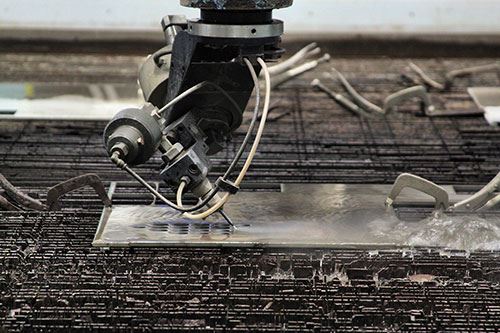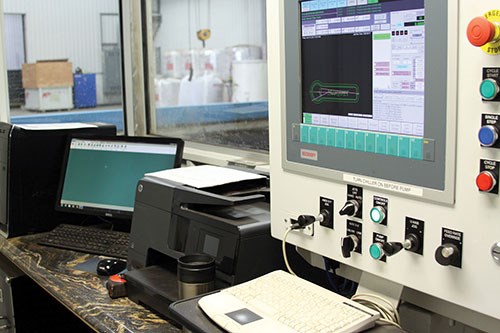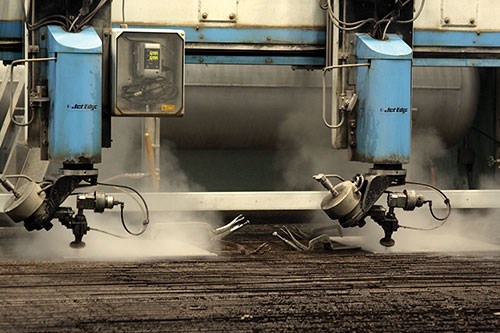Waterjet Helps Machine and Fab Shop Thrive
Adding waterjet technology to it machining and fabrication shop helped Gulf Machine Shop increase productivity and take on new kinds of work.
Share



.png;maxWidth=45)
DMG MORI - Cincinnati
Featured Content
View More




Watch this video for a brief look inside Gulf Machine Shop.
Gulf Machine Shop owner Lloyd Smith remembers the day he decided to make the switch to waterjet at his machine and fabrication shop in Lake Charles, Louisiana. He had quoted a large project for a paper mill and needed a more productive cutting solution than his plasma and arc gouging systems could offer. After some research, he concluded that abrasive waterjet technology could help eliminate secondary operations. He got a quote on a new waterjet system from Jet Edge Waterjet Systems (St. Michael, Minnesota) before the paper mill had even sent him the purchase order.
That was nearly 20 years ago. Today, the shop still keeps its original 8- by 12-foot, dual three-axis waterjet busy, sometimes running it 24 hours a day.
In addition to precision waterjet cutting, Gulf Machine Shop offers machining and fabricating job shop services for single parts or production runs, as well as hard surfacing and dynamic balancing services. The company serves a variety of industries, including oil and petrochemical, and pulp and paper mill industries.
Prior to waterjet, Gulf Machine Shop cut all carbon steel plate with oxy-acetylene flame cutting. Any stainless, nickel alloy, Monel or Hastelloy was cut either by plasma flame or by arc-air gouging. Both methods required cleaning slag from the cut material, and most, if not all, projects required secondary machining operations to get past the heat-affected zone (HAZ) and cut the part to the correct dimensions.
The same was true in the case of the paper mill project, which required the shop to fabricate and machine a wet-end frame using 316L stainless steel. To cut the plate using its plasma cutting system and arc gouging, the shop would have needed to factor in time to knock off the slag and set the plates on a mill for a secondary operation in which the parts would be cut to the correct dimensions prior to fabricating.
Mr. Smith didn’t want to waste hours of manpower knocking off slag, and he certainly didn’t want to tie up his mill correcting parts, so he purchased the Jet Edge waterjet. Not only did it cut parts to the precise dimensions, thus eliminating secondary machining operations, but it also eliminated slag and HAZ.
After years of realizing the benefits of waterjet and its ability to cut more sophisticated parts, Gulf Machine Shop was ready to install another waterjet in 2012, this time an Edge X-5 five-axis system. This waterjet features a 21-by-13-foot work envelope, dual five-axis heads and a custom-built stainless steel tank. It is powered by a 60,000-psi, 150-hp iP60-150 intensifier pump.
Investing in new equipment needed to accomplish its customers’ not-so-common projects and developing its 74 employees’ skills have been crucial to Gulf Machine Shop’s success and longevity. It has helped the 62-year-old shop take on new types of work. The two waterjet systems have given the shop the ability to cut plates that have been hard-surfaced with tungsten carbide alloy to size in one pass. They have also enabled it to take on a wide range of new opportunities. For instance, it has cut a number of heat exchanger tube sheets in which the sheets are placed in the shell at an angle to the shell centerline instead of perpendicular to it. With this configuration, it is necessary to cut the holes in the tube sheets at an angle, and they must be cut in an elliptical shape instead of a circle.
The shop is also is able to process a much wider range of materials, including carbon steel and all-alloy plates, wood, plastics, granite and limestone, firebricks, and sandstone. It cuts carbon steel plate as thick as 6 inches and alloy plates as thick as 3 inches. It has even cut 9-inch-thick firebrick.
According to Mr. Smith, the waterjets also help save material. He took on his first granite cutting job to help his daughter, who was installing 20-mm-thick granite in her medical office. Her fabricator told her she would need to buy three more sheets of granite, but Mr. Smith cut the entire project on his Jet Edge. When he was done, more than 1.5 sheets were left over, and his daughter didn’t need to buy the extra material.
The five-axis waterjet has helped the shop take on more and more challenging projects, Mr. Smith says. “The parts we are required to make are much more complicated than they were 15 to 20 years ago, even 5 years ago,” he says. “The Edge X-5 was a very worthwhile investment. I would hate to do without it.” Mr. Smith says he plans to replace his original Jet Edge with a newer model soon.
The Jet Edge software package also been beneficial, he says. Operators can program movements from the operator station and use an AutoCAD drawing and convert it to a .dxf file. Customers can even email AutoCAD files to the shop, which can then be saved in a .dxf format and downloaded to the machine.
Related Content
Inside the Premium Machine Shop Making Fasteners
AMPG can’t help but take risks — its management doesn’t know how to run machines. But these risks have enabled it to become a runaway success in its market.
Read MoreHigh RPM Spindles: 5 Advantages for 5-axis CNC Machines
Explore five crucial ways equipping 5-axis CNC machines with Air Turbine Spindles® can achieve the speeds necessary to overcome manufacturing challenges.
Read MoreQuick-Change Tool Heads Reduce Setup on Swiss-Type Turning Centers
This new quick-change tooling system enables shops to get more production from their Swiss turning centers through reduced tool setup time and matches the performance of a solid tool.
Read More4 Commonly Misapplied CNC Features
Misapplication of these important CNC features will result in wasted time, wasted or duplicated effort and/or wasted material.
Read MoreRead Next
Registration Now Open for the Precision Machining Technology Show (PMTS) 2025
The precision machining industry’s premier event returns to Cleveland, OH, April 1-3.
Read More5 Rules of Thumb for Buying CNC Machine Tools
Use these tips to carefully plan your machine tool purchases and to avoid regretting your decision later.
Read MoreBuilding Out a Foundation for Student Machinists
Autodesk and Haas have teamed up to produce an introductory course for students that covers the basics of CAD, CAM and CNC while providing them with a portfolio part.
Read More



















.png;maxWidth=150)















.jpg;maxWidth=300;quality=90)









.jpg;maxWidth=300;quality=90)







